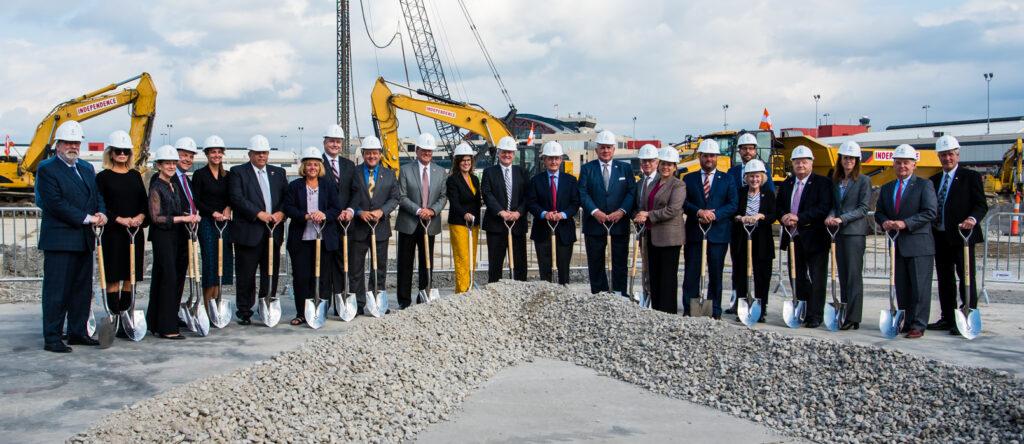
The first US airport terminal to be designed and built post-pandemic, the new facility will incorporate clean air technology and more space for social distancing. It will also feature outdoor terraces—both pre- and post-security—to ensure access to fresh air, a rarity for domestic airports.

Modernization of the airport involves construction of a new 700,000-sq.-ft. terminal that will include ticketing, security checkpoints and baggage claim. An adjacent complex includes a new 3,300-space parking garage, rental car facilities and new roadways.

The new $1.39 billion terminal is intended to “right-size” the airport and focus on public health, sustainability and innovation.

Airport officials and local dignitaries at the groundbreaking for Pittsburgh International Airport’s (PIT) new terminal on Oct. 14, 2021. During construction, PIT said a minimum of 75% of waste generated will be recycled or reused, including concrete from existing airfield ramps that will be reused for new roads. Additional plans include rainwater harvesting and other water conservation efforts.

PIT CEO Christina Cassotis was joined onstage by Allegheny County Executive Rich Fitzgerald. Cassiotis said, “We are breaking ground on so much more than a building or a complex. We are really breaking ground on the region’s future. We are not the airport of yesterday.”

Allegheny County Executive Rich Fitzgerald said, “We need an airport to reflect all of those changes and where we are going as a community and as a region.”

More than 300 people attended the ceremonial groundbreaking of the airport’s Terminal Modernization Program, a new $1.39 billion terminal intended to “right-size” the airport and focus on public health, sustainability and innovation. Guests included community partners, elected officials, airline representatives and business leaders.

PIT CEO Christina Cassotis said the construction project is about “more than steel beams and poured concrete,” saying the authority also has lofty goals for workforce diversity and participation by women- and minority-owned businesses among other efforts to offer equal access to opportunities. “There’s no taxpayer money involved in this. This is something that is important because it’s very expensive to run a 34-year-old facility. You have to retrofit for technology to come up to speed with all the innovations that has come into the industry in 34 years.

Officials are seeking LEED certification at the silver level or beyond for the project, which will require more than 12,000 tons of steel, 94,000 tons of concrete and more than 354,000 sq. ft. of wood materials, much of which the airport hopes to source locally.

Allegheny County Airport Authority chief development officer and project head Paul Hoback said, “We have been able to come up with a plan where we’re able to completely separate the construction site from the actual airport operations, with a minimal impact on our passengers.” He added: “To ensure the new terminal embodies the best qualities of the Pittsburgh region, we are engaging area nonprofits, foundations and other businesses to partner on various aspects of design and implementation.”

Landside North. Built with a focus on public health and technology, the new facility will incorporate clean air technology, more space for social distancing and 90,000 sq. ft. of outdoor terrace space – both pre- and post-security – to ensure access to fresh air.

Key design features, developed by architectural and engineering firms Gensler and HDR in association with luis vidal + architects are centered on elements of nature and sustainability, leading-edge technology, and innovation in the community.

The new Pittsburgh International Airport “will be built for and by the people of this region,” said PIT CEO Christina Cassotis. “This new terminal represents the region’s DNA, and it will mirror Pittsburgh and our many rich cultures.”

According to PIT, this “airport of the future” will act as a model for other large-scale transportation projects and will include 90,000-sq. ft. of outdoor terraces, a rainwater harvesting program and emerging touchless technology.

Overall view. The multi-modal complex includes a new 3,300-space parking garage, rental car facilities and entrance roadways, all designed to improve the passenger experience. According to an economic impact report created by EBP US Inc., the new terminal, expected to open in 2025, will generate $2.5 billion for the local economy and add some 5,500 local construction and skilled labor jobs, along with 8,500 other jobs. It will generate $27 million in local tax revenue.

The new terminal will consolidate operations, including ticketing, security checkpoints and baggage claim, dramatically improving the passenger experience.

The single terminal design reduces passenger travel time by 50% to get from the curb to airside.
Pittsburgh International Airport (PIT) broke ground on a $1.4 billion new terminal project on Oct. 14, 2021. It is expected to open in 2025. This is the first new airport to be built from the ground up in a post-pandemic world and will combine landside and airside operations into one modern, adaptable facility. According to PIT, this “Airport of the Future” will act as a model for other large-scale transportation projects and will include 90,000-sq. ft. of outdoor terraces, a rainwater harvesting program and emerging touchless technology.
All photos and renderings courtesy of Pittsburgh International Airport.

Comments